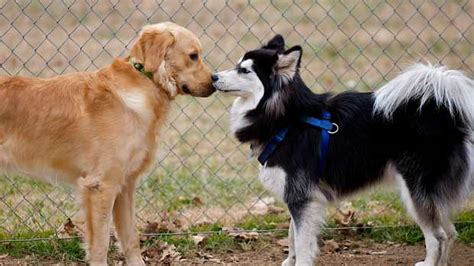
A Golden Retriever puppy’s persistence and undeniable charm have gone viral after a video surfaced showing its adorable attempts to coax its older brother, who suffers from stair-related anxiety, down a flight of steps. The heartwarming display of canine compassion has captured the internet’s attention, showcasing the powerful bond between the two dogs and the puppy’s surprising emotional intelligence.
The viral video, initially posted on social media, documents the unwavering support the younger dog, whose name wasn’t released, provides to his older sibling. The older Golden Retriever, visibly hesitant and seemingly gripped by fear, remains at the top of the stairs, paralyzed by his anxiety. In response, the puppy employs a range of tactics, including gentle nudges, playful bows, and irresistible puppy-dog eyes, all in an effort to encourage his brother to overcome his phobia.
The video’s popularity stems from its relatable depiction of overcoming fears and the undeniable cuteness of the interaction. Social media users have praised the puppy’s empathetic behavior, commenting on the profound connection between the two animals. Many viewers admitted to being deeply moved by the display of inter-dog support.
“It’s just amazing to see such a young animal displaying such empathy and understanding,” commented one user. “This puppy deserves all the treats in the world.”
The video has not only entertained but has also sparked discussions about animal behavior and the capacity for emotional intelligence in dogs. Experts suggest that the puppy’s actions are likely driven by a combination of instinct, learned behavior, and a strong social bond with its older brother.
Dr. Emily Carter, a certified veterinary behaviorist, explains, “Dogs are highly social animals, and they often mirror the emotions of their pack mates. In this case, the puppy may be sensing the older dog’s distress and attempting to alleviate it through playful interaction and encouragement.”
The incident has also shed light on the issue of anxiety in dogs, which is more common than many pet owners realize. Stair-related phobias, like the one exhibited by the older Golden Retriever, can develop due to a variety of factors, including past negative experiences, genetic predispositions, or simply a lack of early exposure to stairs.
“It’s important for pet owners to be aware of the signs of anxiety in their dogs and to seek professional help if necessary,” advises Dr. Carter. “There are many effective treatments available, including behavior modification therapy, medication, and environmental adjustments.”
The success of the puppy’s mission remains unknown, as the video ends before the older dog fully commits to descending the stairs. However, the overwhelming response to the video suggests that the puppy’s efforts have already had a positive impact, raising awareness about canine anxiety and the importance of compassion and support.
The Golden Retriever breed is known for its friendly and intelligent nature, and this viral video serves as a testament to these qualities. The puppy’s unwavering dedication to helping its brother has resonated with viewers worldwide, reminding us of the power of empathy and the unique bonds we share with our animal companions.
The video continues to circulate online, garnering millions of views and inspiring countless acts of kindness. It stands as a heartwarming reminder that even the smallest gestures can make a big difference in the lives of others, both human and canine.
The phenomenon also reflects a broader trend of animal-related content dominating social media platforms. The inherent appeal of cute and heartwarming animal interactions taps into a universal desire for positivity and connection, providing a welcome respite from the often-negative news cycle.
The heartwarming story of the Golden Retriever puppy and its stair-fearing brother serves as a powerful reminder of the emotional depth and complex social dynamics within the animal kingdom. It also highlights the importance of understanding and addressing anxiety in pets, promoting responsible pet ownership and fostering stronger bonds between humans and their animal companions.
Expanded Details and Context
The Golden Retriever breed, originating in Scotland in the mid-19th century, was developed to retrieve waterfowl for hunters. Their inherent characteristics, such as intelligence, eagerness to please, and gentle disposition, have made them popular family pets worldwide. Their friendly nature extends not only to humans but also to other animals, as demonstrated in the viral video.
The concept of anxiety in dogs is increasingly recognized by veterinarians and pet owners alike. While occasional nervousness is normal, persistent anxiety can significantly impact a dog’s quality of life. Common signs of anxiety include excessive barking, panting, pacing, destructive behavior, trembling, and, as seen in the video, reluctance to engage in certain activities like climbing or descending stairs.
Stair-related anxiety can stem from a variety of sources. Puppies who haven’t been properly introduced to stairs during their critical socialization period (typically between 3 and 16 weeks of age) may develop a fear of them later in life. Traumatic experiences, such as a fall on the stairs, can also trigger anxiety. In some cases, underlying medical conditions, such as arthritis or hip dysplasia, can make navigating stairs painful and contribute to the development of a phobia. Additionally, some dogs may simply have a genetic predisposition to anxiety, making them more prone to developing phobias regardless of their early experiences.
Addressing anxiety in dogs requires a multifaceted approach. Behavior modification therapy, often guided by a certified veterinary behaviorist or qualified dog trainer, is a common and effective treatment. This typically involves desensitization and counterconditioning techniques, which gradually expose the dog to the feared stimulus (in this case, stairs) in a safe and controlled environment while pairing it with positive reinforcement, such as treats and praise. The goal is to change the dog’s emotional response to the stairs from fear to positive association.
Medication can also be a valuable tool in managing anxiety in dogs. Anti-anxiety medications, prescribed by a veterinarian, can help reduce the dog’s overall anxiety level, making them more receptive to behavior modification therapy. These medications are not a cure for anxiety but can provide much-needed relief and improve the dog’s ability to cope with stressful situations.
Environmental adjustments can also play a significant role in alleviating stair-related anxiety. Providing non-slip surfaces on the stairs, such as carpets or runners, can increase the dog’s confidence and reduce the risk of slips and falls. Using a harness or leash to guide the dog up and down the stairs can also provide a sense of security. In some cases, completely avoiding the stairs may be the best option, especially if the dog’s anxiety is severe and unresponsive to other treatments.
The viral video of the Golden Retriever puppy and its stair-fearing brother underscores the importance of early socialization and training in preventing anxiety in dogs. Exposing puppies to a variety of environments, people, and situations during their critical socialization period can help them develop into well-adjusted and confident adults. Positive reinforcement training techniques, which focus on rewarding desired behaviors, can also help build a strong bond between the dog and owner and promote a sense of security and trust.
Furthermore, the video highlights the power of observation and empathy in dogs. While it’s difficult to definitively attribute human emotions to animals, the puppy’s actions strongly suggest that it recognized its brother’s distress and was attempting to alleviate it. This level of social awareness is not uncommon in dogs, particularly in breeds known for their intelligence and sensitivity.
The popularity of the video also speaks to the growing awareness of animal welfare and the increasing recognition of animals as sentient beings with complex emotional lives. As society becomes more attuned to the needs and feelings of animals, there is a greater demand for content that celebrates the bonds between humans and animals and promotes responsible pet ownership.
The internet has played a significant role in fostering this increased awareness. Social media platforms provide a space for pet owners to share their experiences, connect with other animal lovers, and learn about animal behavior and welfare. Viral videos like the one featuring the Golden Retriever puppy can have a powerful impact, raising awareness about important issues and inspiring acts of kindness and compassion.
The continued circulation of the video serves as a reminder that even small acts of kindness can have a profound impact. The puppy’s unwavering support for its brother is a testament to the power of empathy and the unique bonds we share with our animal companions. It also highlights the importance of understanding and addressing anxiety in pets, promoting responsible pet ownership and fostering stronger relationships between humans and animals.
The story extends beyond a simple, cute animal video. It demonstrates the growing understanding of animal psychology and welfare, reinforcing the need for responsible pet ownership and the importance of addressing behavioral issues like anxiety. This incident serves as a call to action for pet owners to be more attentive to their pets’ emotional needs and to seek professional help when necessary.
The video’s appeal also lies in its simplicity. It is a pure, unadulterated display of canine affection and support, offering a moment of respite from the complexities and challenges of daily life. The heartwarming interaction between the two dogs reminds us of the importance of empathy, compassion, and the power of positive reinforcement.
The broader impact of the video is that it encourages viewers to reflect on their own relationships and to consider how they can provide support and encouragement to those around them, whether human or animal. It’s a reminder that even small gestures of kindness can make a big difference in the lives of others.
The financial aspect of caring for animals with anxiety is also a crucial consideration. Behavior modification therapy can be expensive, and medication can add to the ongoing costs of pet ownership. Pet insurance can help offset some of these expenses, but it’s important to research different policies carefully to ensure they cover behavioral issues.
The long-term effects of untreated anxiety in dogs can be significant. Chronic stress can weaken the immune system, making the dog more susceptible to illness. It can also lead to behavioral problems, such as aggression and destructiveness, which can further strain the relationship between the dog and owner.
Therefore, early intervention is key to managing anxiety in dogs. Recognizing the signs of anxiety and seeking professional help can prevent the condition from worsening and improve the dog’s overall quality of life. The viral video of the Golden Retriever puppy serves as a powerful reminder of the importance of being attentive to our pets’ emotional needs and providing them with the support and care they deserve.
Frequently Asked Questions (FAQ)
Q1: What caused the older Golden Retriever to be afraid of stairs?
A1: The article states that stair-related phobias in dogs can develop due to various reasons, including past negative experiences (like a fall), genetic predispositions to anxiety, a lack of early exposure to stairs during their critical socialization period (3-16 weeks), or underlying medical conditions that make navigating stairs painful (e.g., arthritis). Without specific details from the owner, the exact cause in this particular case is unknown.
Q2: What tactics did the puppy use to help its brother overcome his fear?
A2: According to the rewritten article, the Golden Retriever puppy employed a range of tactics to encourage its older brother to descend the stairs. These included gentle nudges, playful bows, and irresistible puppy-dog eyes. The puppy seemingly tried to coax, encourage, and reassure its brother with these affectionate gestures.
Q3: What did experts say about the puppy’s behavior and what does it tell us about dogs in general?
A3: Dr. Emily Carter, a certified veterinary behaviorist, suggests that the puppy’s actions are likely driven by a combination of instinct, learned behavior, and a strong social bond with its older brother. She explains that dogs are highly social animals and often mirror the emotions of their pack mates. The puppy may be sensing the older dog’s distress and attempting to alleviate it through playful interaction and encouragement. This highlights the emotional intelligence and social awareness that dogs can possess.
Q4: What are some common signs of anxiety in dogs that pet owners should be aware of?
A4: Common signs of anxiety in dogs include excessive barking, panting, pacing, destructive behavior, trembling, and reluctance to engage in certain activities like climbing or descending stairs. These signs can vary in intensity and may be triggered by specific situations or be more generalized. If a pet owner notices these signs, it’s important to consult with a veterinarian or veterinary behaviorist.
Q5: What are some potential treatment options for dogs with anxiety, especially stair-related anxiety?
A5: Treatment options for dogs with anxiety, including stair-related anxiety, include behavior modification therapy (desensitization and counterconditioning), medication (anti-anxiety medications prescribed by a veterinarian), and environmental adjustments (non-slip surfaces on stairs, harness/leash guidance). In some cases, avoiding the stairs altogether may be the best option. Early intervention is crucial for managing anxiety and improving the dog’s quality of life.









